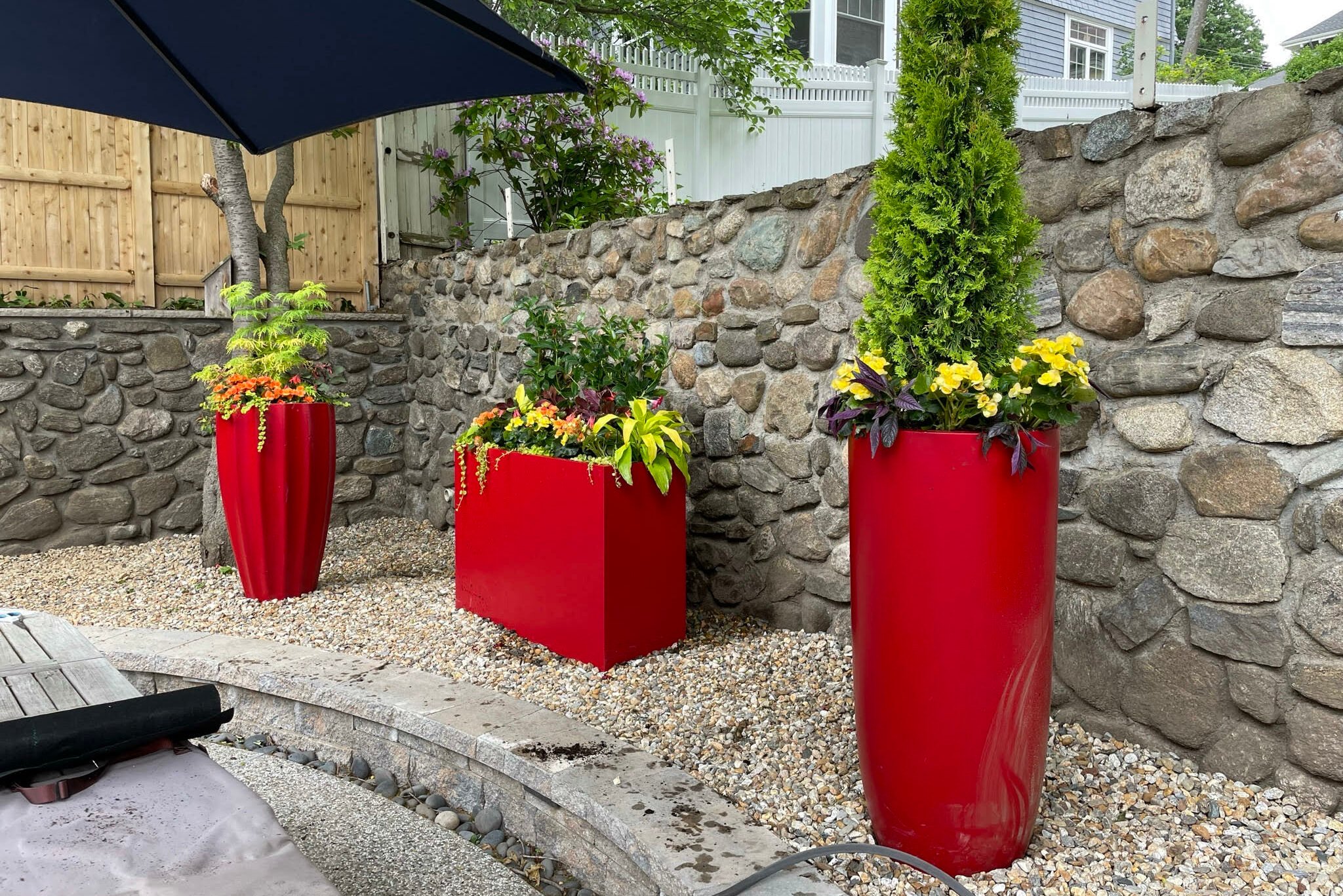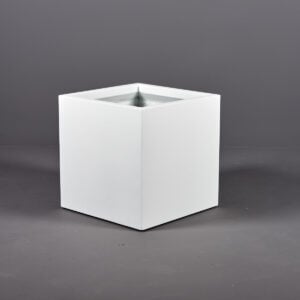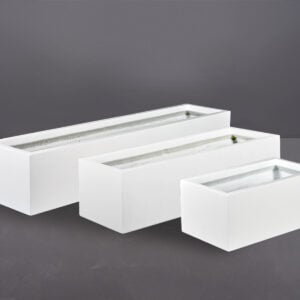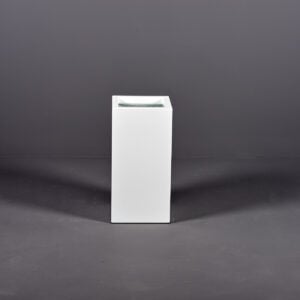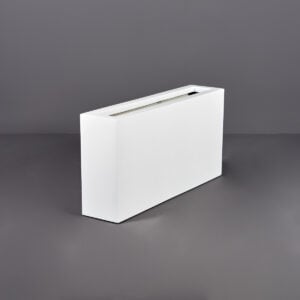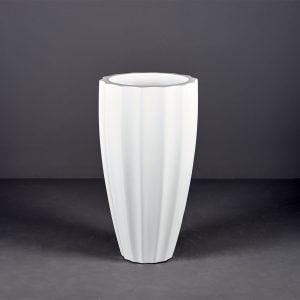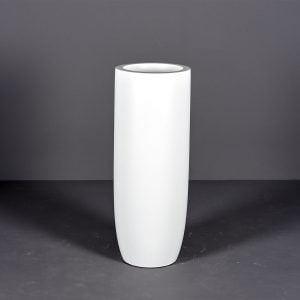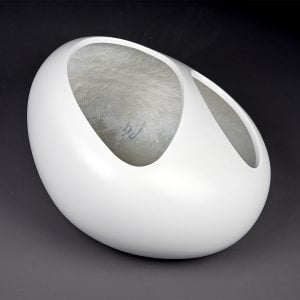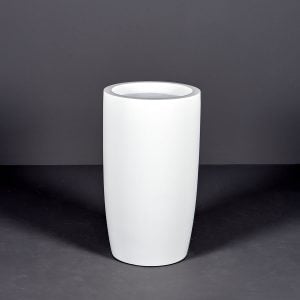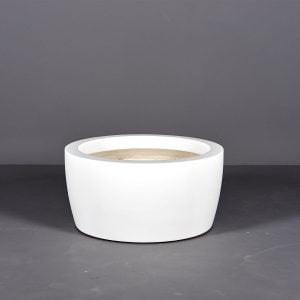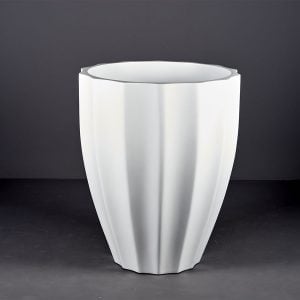After many hours of thinking, researching, and searching for that perfect plant to perk up your interior, or to add a little life to your exterior, now you think, what about the container? What options are there? Well, the most important consideration revolves around planter materials.
- What Are Planters Made Out Of?
- 1. Fiberglass Planters
- Our Favorite Fiberglass Planters
- 2. Concrete Planters
- 4. Terracotta And Ceramic Planters
- 5. Metal Planters
- 6. Wood Planters
- 7. Foam Planters
- What Is The Best Material For Outdoor Planters?
- See Jay Scotts Planters In Action!
- Our Favorite – Fiberglass Planters
What Are Planters Made Out Of?
There is a whole spectrum of planter materials on the market. Choosing the right material will make a big difference to the health of your plants and will also ADD to the visual appeal of your interior or exterior. The most common planter materials are:
- Concrete planters
- Fiberglass planters
- Plastic planters
- Ceramic planters
- Terracotta planters
- Foam planters
Planters that use natural materials are less common but also have their pros, such as wood and metal planters. This guide will run the gamut, and with a little analysis, help you choose the best planter for you and your plants.
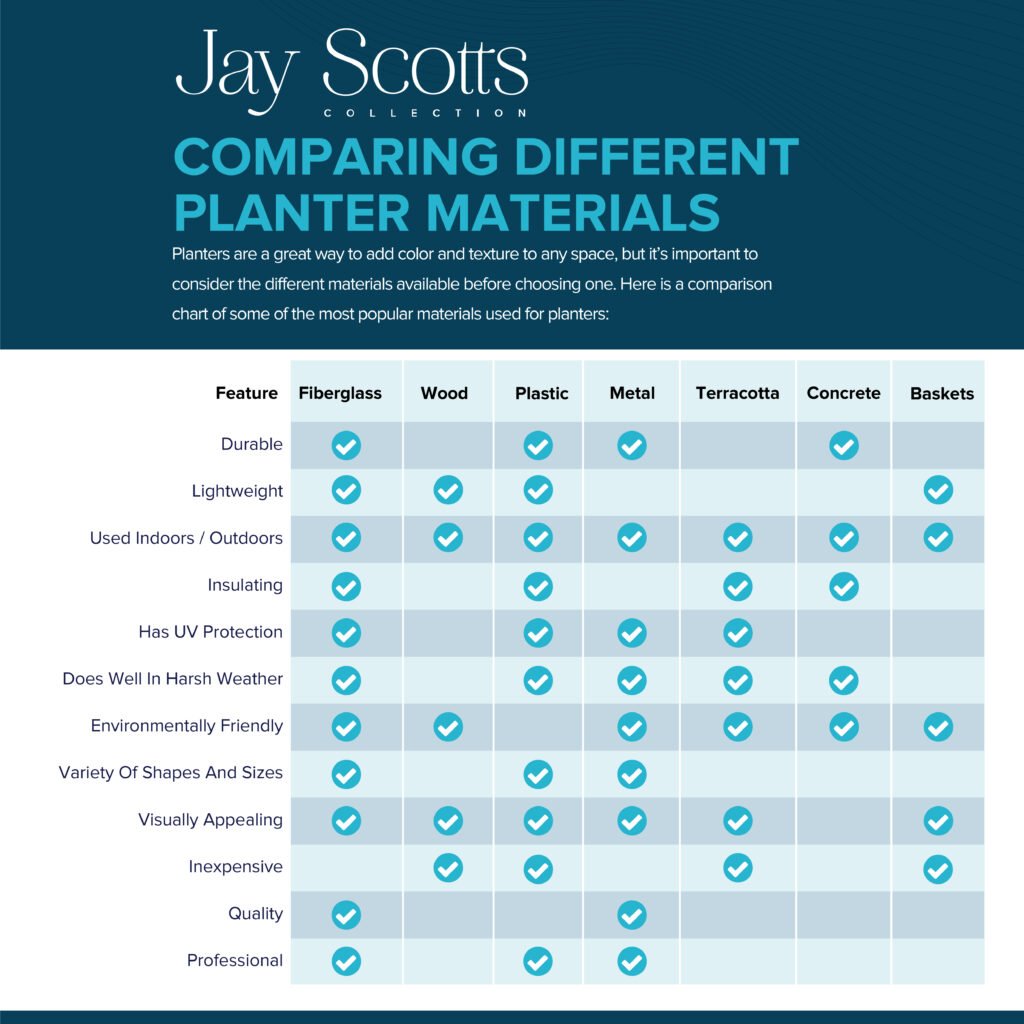
1. Fiberglass Planters
Fiberglass is a relatively new and modern material. To make it, glass is spun into a fiber and then mixed with a resin to create a very strong and flexible composite. This fiberglass and resin mixture is then put into a mold to create various shapes and sizes. A few rounds of sanding and a layer of primer give the fiberglass planter a flawless and protective finish. Drainage holes can be drilled into the bottom to allow adequate drainage.
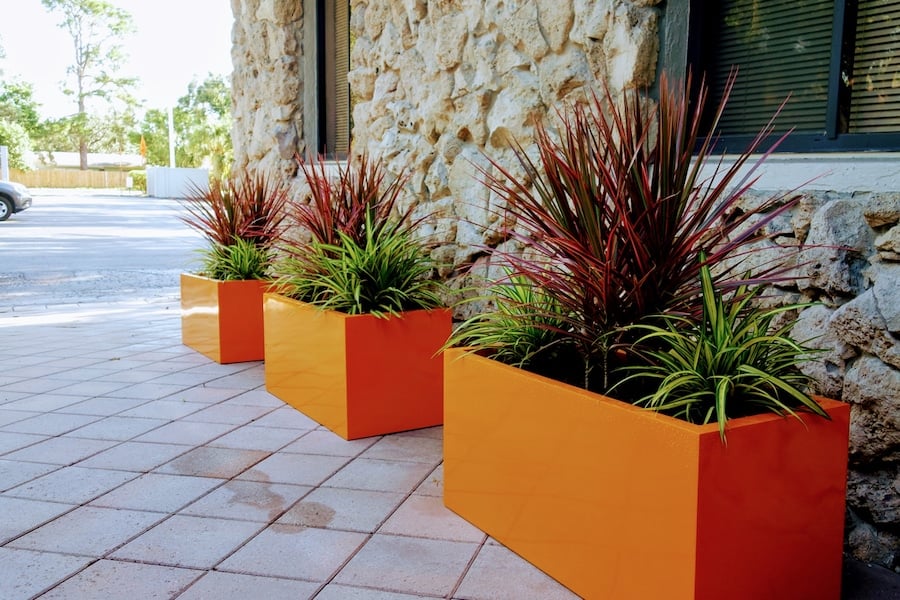
Advantages
Durability – Fiberglass containers are extremely strong and flexible. They can be utilized both indoors and outdoors and can take quite a beating. Plus, any little scratches and wear-and-tear can be buffed out or painted over really easily.
Quality – Despite the low cost, Jay Scott’s attention to detail and high manufacturing standards create fiberglass pots with superior quality in regards to their strength and finish. Fiberglass pots are also really lightweight so they are an ideal material for large containers.
Plant health – Fiberglass is a material known for its plant-protection qualities. The health benefits of buying fiberglass include UV protection for hot climates and waterproofing, and because it’s not a porous material, it won’t leech chemicals into the soil and harm your plants, perfect for growing edibles!
Disadvantages
Cost – Fiberglass pots are relatively cheap to produce compared to heavier materials such as wood and metal, but it is more expensive than plastic and terracotta. If you want a planter that stays as good as new for longer and is healthier for your plants, pay a little extra and buy fiberglass.
Manufacturer dependent – Some manufacturers cut corners when they produce this material. The way they do this is by adding more resin and fillers that don’t have any structural benefit but do add to the weight. So watch out for heavy fiberglass planters, this is a sign of an inferior product.
Learn more about why fiberglass planters are the first choice for developers and landscapers.
Our Favorite Fiberglass Planters
While we offer 100’s of different planter designs, shapes, and sizes (and we can custom-make planters too), here are some of our favorites:
-
Cuba Low Corner Planter
-
Cuba Low Rectangular Planter
-
Miami Short Corner Planter
-
Miami Rectangular Planter
-
San Jose Tall Fluted Round Planter
-
Salon Narrow Low Rectangular Planter
-
Saint Tropez Bullet Round Planter
-
River Rock Planter (Large)
-
Montroy Cube Planter
-
Lisbon Tall Round Tapered Planter
-
Casablanca Bowl Planter
-
Alicante Fluted Round Planter
2. Concrete Planters
Manufacturing concrete for any purpose consists of mixing cement paste with water, sand, and rock to create the final product. In industrial concrete production, a combination of chemicals such as calcium, silicon, aluminum, and iron are used to help bind and harden the mixture. Wet concrete is poured into the desired shape using a mold. When left unpainted, concrete is a light gray color. However, they can be jazzed up in any color you like using masonry paint.

Advantages
Color – Concrete planters can be aesthetically neutral in a busy color scheme due to their natural light-gray color. They can also be painted easily at home with a variety of paints, though masonry paint is the best. This leads to endless DIY and customization fun.
Weight – Concrete is quite heavy and hardy. This makes it ideal as an outdoor planter for large plants where strong winds and weathering would otherwise do some destruction (not ideal for indoor use or if you want to rearrange your planters often).
Shapes and sizes – Due to the nature of the molding process, concrete containers can come in any shape and some very large sizes. It also means that manufacturers can offer bespoke designs for custom orders.
Disadvantages
Environment – Concrete is environmentally damaging to produce along the supply chain. For example, manufacturing cement produces a lot of C02 which contributes to global warming.
Fragile – Though concrete is strong, it is also brittle. A few hard knocks during delivery and you need to order replacements. Remember to cover or move outdoor planters during winter so that water doesn’t pool in them and then freeze. Over time this can crack the concrete.
Plant health – Concrete contains lime which can leech into the potting soil. This creates an alkaline Ph balance that is great for succulents, but for many other plants, it can stunt growth. In addition, concrete is porous so pots can lose moisture quickly.
Fiberglass planters vs. Concrete planters
When talking about long-time durability and strong up-front investment, it really only comes down to fiberglass and concrete. Both of these planter types have long lifespans as well as are incredibly durable, but concrete planters cannot be moved without running the risk of structural damage to the surrounding property. On the other hand, our larger fiberglass can still be easily moved even when they’re filled with soil and plants.
Concrete planters will be coarser to the touch than fiberglass planters. While they are both capable of being painted in a wide variety of colors, concrete planters will always have a slightly muted tone to them due to the material. The overall quality of fiberglass planters makes them a more worthy option. With fiberglass, you’re receiving easier maneuverability with brighter colors for the same long lifespan.

3. Plastic Planters
Plastic is the wonder material that first entered the world stage in 1907. Since then, all kinds of containers have been manufactured using plastic. Plastic pots are made from crude oil which is a non-renewable resource. Nevertheless, huge industries exist to extract and then process the oil needed to create plastic containers. Nowadays, there are many different kinds of plastic for a range of purposes, such as uPVC which is considered safe to use for growing food.

Advantages
Cheap – Plastic is possibly the most mass-produced material in human history. It is extremely cheap to make and mold into any shape or style. The standard supermarket plant pot is plastic.
Light – One reason why plastic is so popular the world over is that its strength-to-weight ratio is very high. Plastic pots can be very thin, shipped across the world, dropped a few times, and still do the job.
Disadvantages
Environment – Plastic has many harmful effects on the environment. Just one example is that plastic is so durable that it takes thousands of years to degrade. During this time, toxins from the plastic container can leech into the groundwater, enter the food chain, and cause harm to whole ecosystems.
Plant health – As mentioned above, plastic releases chemicals that are organically harmful. This is why it is important to choose the right kind of plastic. If you want to grow vegetables. look for planters made with uPVC to minimize the number of chemicals that get sucked up by your poor plants.
Single-use – Though touted as durable, plastic can become very brittle and crack when exposed to sun and heat for extended periods. A plastic pot may only last one season before a crack renders it useless.
Fiberglass planters vs. Plastic planters
In appearance, both materials are able to represent a wide range of colors but unfortunately, plastic is a very cheap substance and it will look cheap too. When it comes to implementing color, producers of plastic planters often melt the plastic with the color or dye the plastic and then add the color. This can make for some bright colors, but it lessens the overall quality of the color. With our painted fiberglass, we use the same paint that gives contemporary automobiles their sleek appearance and amazing reflections if the gloss is used.
Both planters won’t negatively impact plant health. However, plastic planters are more easily eroded. Fiberglass is superior at maintaining and regulating temperatures, whereas plastic can morph in high heat and crack in the cold. On the whole, fiberglass is much more durable than plastic. It can hold its shape better while also maintaining its structural integrity for a much longer time.

4. Terracotta And Ceramic Planters
Ceramic and terracotta are essentially just slight variations on the same material, clay. Terracotta is the name of the particular type of clay used, and it does have different properties. For example, it is iconically reddish-brown in color and sports a rustic look, whereas ceramic is a light-colored clay. Ceramic is often glazed on the outside while terracotta is not.
Use glazed ceramic pots to keep your plants hydrated as the glazing seals the pot and stops leakage. On the other hand, unglazed terracotta looks great and is well-suited for plants that like a lot of drainage.

Advantages
Cost – Clay pots of either kind can range from very cheap and cheerful to outlandishly expensive and luxurious. This material creates inexpensive containers that can be reused time after time, saving more money.
Durable – Ceramic planters which are glazed are extremely durable and can last decades of direct sun and cold climates. Both terracotta and ceramic pots can be reused safely
Appearance – Terracotta is usually left unglazed on the outside. The outside will flake and age over time with further baking and weathering. This gives it a natural look and is visually appealing both in the garden and inside.
Disadvantages
Weight- Terracotta and ceramic planters are quite heavy so are not the best planter to move around constantly. If you have large plant pots it becomes impossible to arrange them easily. This is not the greatest material for pots that need to come inside during the winter.
Brittle – Plant containers made of clay are prone to cracking if dropped and need a rather careful delivery, especially for really large containers. The porous nature of clay is also something to worry about during winters when freezing and thawing can produce fissures and over time cracks and chips.
Fiberglass planters vs. Terracotta planters
The biggest difference between terracotta and fiberglass planters is their customizability. Fiberglass has much more room for customizability regarding colors, and it is being adopted much more into modern interior design. Terracotta has to be changed at a molecular level to alter the color while fiberglass planters can be repainted. Fiberglass planters are also much lighter than terracotta planters, which makes it much easier to move them around. Terracotta pots often have a very weighty feel to them too.
Both of these materials bring a unique appearance, and for many people’s small gardens at home, terracotta pots and planters are frequent fillers due to their rustic appeal. Both the planter materials offer great support and breathing room for plants to grow and root, but terracotta planters are also prone to cracking in cold weather and retain excess heat which can damage the plant root.
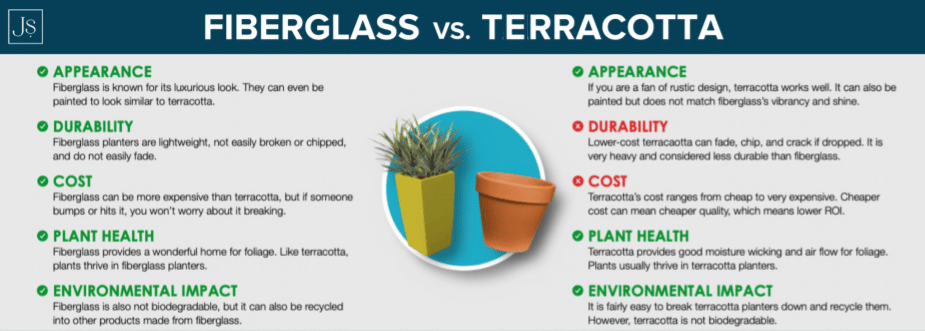
5. Metal Planters
There are various kinds of metal containers on the market, but the most common materials used are steel, aluminum, zinc, and copper. As an outdoor planter, metal containers, especially steel, will rust over the years to become red in hue. This process is quickened by the outside elements. Metal materials are not porous and so to ensure good drainage, drill holes in the bottom to allow water to leave and create good airflow.

Advantages
Strength – Metal containers are extremely strong and durable. They won’t chip, crack, or scratch, and can be left outside to age with no problems. Galvanized steel is even stronger and will be more weather-resistant compared to other planters in your container garden.
Appearance – Metal containers are a great addition to any decor, especially as they are available in a wide range of metals that can be used. Choose the right metal for your style. Galvanized steel, aluminum, and zinc have the industrial look that many interior designers chase. Copper and rusted steel on the other hand are very rustic and fit in well with a farm-kitchen decor.
Disadvantages
Weight- Metal containers can be quite heavy in large sizes and are not ideal to move around very often. The benefit is that they won’t be blown around or knocked over very easily. This makes them a great choice for large corporate settings where a strong industrial look is sought-after.
Overheating – When left in direct sunlight, metal containers can get very hot and damage the roots of your plants. For this reason, it’s best to keep metal planters in the shade or bring the planters inside on a hot day.
Fiberglass planters vs. Metal planters
While fiberglass is interwoven fibers that are layered atop each other, metal planters often have either a dull or bright shine to them due to the sun. They are both lightweight and easy to maneuver, but when it comes to plant health, fiberglass takes the cake. Metal planters are too risky for outside and inside plant health. On the outside, excess heat can burn and damage the soil and the plants. Inside, the metal can rust and cause oxidation to occur at the bottom of the plants, rusting them too.
Metal planters are highly prone to rust which can also degrade the integrity of the pot and cause holes. Considering the importance of watering plants, it is incredibly common for metal planters to start showing damage signs. Fiberglass planters, on the other hand, do not have any risk of rusting due to the lack of iron in the planter composition.

6. Wood Planters
Wooded containers are made with a variety of different natural materials. The most common varieties are rosewood, cedar, hemlock, fir, and pine. Other materials such as bamboo pots are extremely lightweight. Planks and beams are cut from these trees to make lumber. This is then cured and treated for several months to increase the waterproofing and strength of the pot.

Advantages
Natural material – Wooden pots are made from natural materials and don’t pose a threat to plant health. Though you do need to give them extra attention to make sure there is no rot. This involves applying a coat of polyurethane, varnish, or lacquer to seal the wood from moisture and weathering, and it looks great too.
Appearance – One feature of wood is how natural and humble wooden pots look as an outdoor planter, and how they are very ornamental when used indoors. Bamboo planters are ideal hanging baskets for their visual appeal. Wooden plant pots come in a wide range of styles that don’t work with other planter materials. For example, a hollowed-out tree trunk looks rustic in wood but tacky in plastic.
Disadvantages
Life span – The average wooden planter will last around 10 – 20 years with a bit of love and the occasional maintenance. This sounds like a long time but compared to fiberglass, which lasts forever, wooden planters are slightly on the short life span side.
Cost – Planters made from wood are a lot more expensive than mass-produced plastic pots for example. The most expensive woods are cedar and rosewood, though these are the most beautiful and are waterproof too.
Fiberglass planters vs. Wooden planters
While each has its unique appearance, wooden planters and pots have a much more specific aesthetic than fiberglass planters. If you are going for a rustic or vintage look, then wood might be the superior planter for you, but it also comes with limitations. Fiberglass is better at handling varying climates. If wood is properly sealed and varnished it will be okay for the variances, but humidity will break down a wooden planter faster than a fiberglass one. In an office setting the degradation will be slower, but the wood will go before the fiberglass does.
Fiberglass is also much more customizable than wood. The variety of painting solutions and styles we provide can make them virtually indistinguishable from all the other materials out there, except for wood. Wood is best at looking like itself though you can hide the fact by using different paints or styled cuts. But ultimately, it won’t look better than an alternative, and it would often cost much more to make it look like its cheaper counterpart.

7. Foam Planters

Foam planters are made from plastic chemicals such as Polyurethane and Polyethylene and can come in several different grades ranging from thin to thick. Polyurethane has more insulation than other foam materials and is ok to be left outside over summer and winter – but just ok.
Both foam materials produce a pot that visually looks a little like terracotta and can be manufactured into a little run of shapes, sizes, and textures. The biggest highlight of foam is the impressive strength-to-weight ratio that it holds, though, with cheap foam containers, there is no strength as well as no weight.
Advantages
Weight – Foam is one of the lightest materials on the market. A foam container is perfect for transporting your plants around if ever you move house!
Price – Foam planters are quite cheap so often they are the plant pot that the nursery gives you before you find something better.
Disadvantages
Durability – Foam planters are not meant for long-term use and even the best products typically won’t last more than 2 winters.
Environment impact – Though the overall structure will stay intact for a few years, foam is prone to chipping and shedding all over the place which essentially amounts to the spread of plastic pollution.
Fiberglass planters vs. Foam planters
Fiberglass and foam planters might be the furthest apart in terms of their structural integrity, quality, and price. While there have been great advances in the visual appeal of foam planters, there is still a large disparity regarding customizable choices between fiberglass and the limited foam opponent. Fiberglass is far more durable than foam but naturally, if not handled properly and with care, both can suffer cosmetic damage impacting the visible integrity of the containers.
Temperature control is a bit of a wash. In colder climates, both of these planter materials operate effectively at keeping the plant healthy. However, at higher temperatures, the foam can degrade and release chemicals that are harmful to the plant’s health. The only positive to working with foam planters is the fact that they are cheaper than fiberglass. Unfortunately, they are cheaper in more ways than one.

What Is The Best Material For Outdoor Planters?
The best material for outdoor planters is fiberglass regardless of the application. With high performance and low environmental impact, fiberglass planters outperform cheaper and more expensive options. To grow plants such as flowers in a cheap plastic container is OK, but for plant displays for beauty and elegance, or for growing edibles, fiberglass planters are much more impactful, and safer health-wise!
Though some may be worried about the weight, fiberglass is much stronger than plastic and is just as light.
Before choosing an outdoor planter material, think about the style that you want to follow, and what materials allow you to achieve this style. Again, fiberglass planter designs are extremely versatile and can be produced in near enough any size and shape. Plus, the range of colors that fiberglass supports is virtually endless!

Also, decide if you will be moving these pots inside during the winter. Concrete and metal are too heavy and wood will fall apart with too much back and forth. Plastic and foam are also an option because they are light, but they may also crack too easily. Again, fiberglass is ideal because it can withstand all the elements of the great outdoors, and it is strong and light enough to move inside when necessary.
See Jay Scotts Planters In Action!
Check out our project for Pura Vida, a health and decor-conscious restaurant in Miami, Florida that
came to us with a challenge: create a private patio area that draws in diners while offering peace and
tranquillity once inside. Take a look at our solution!
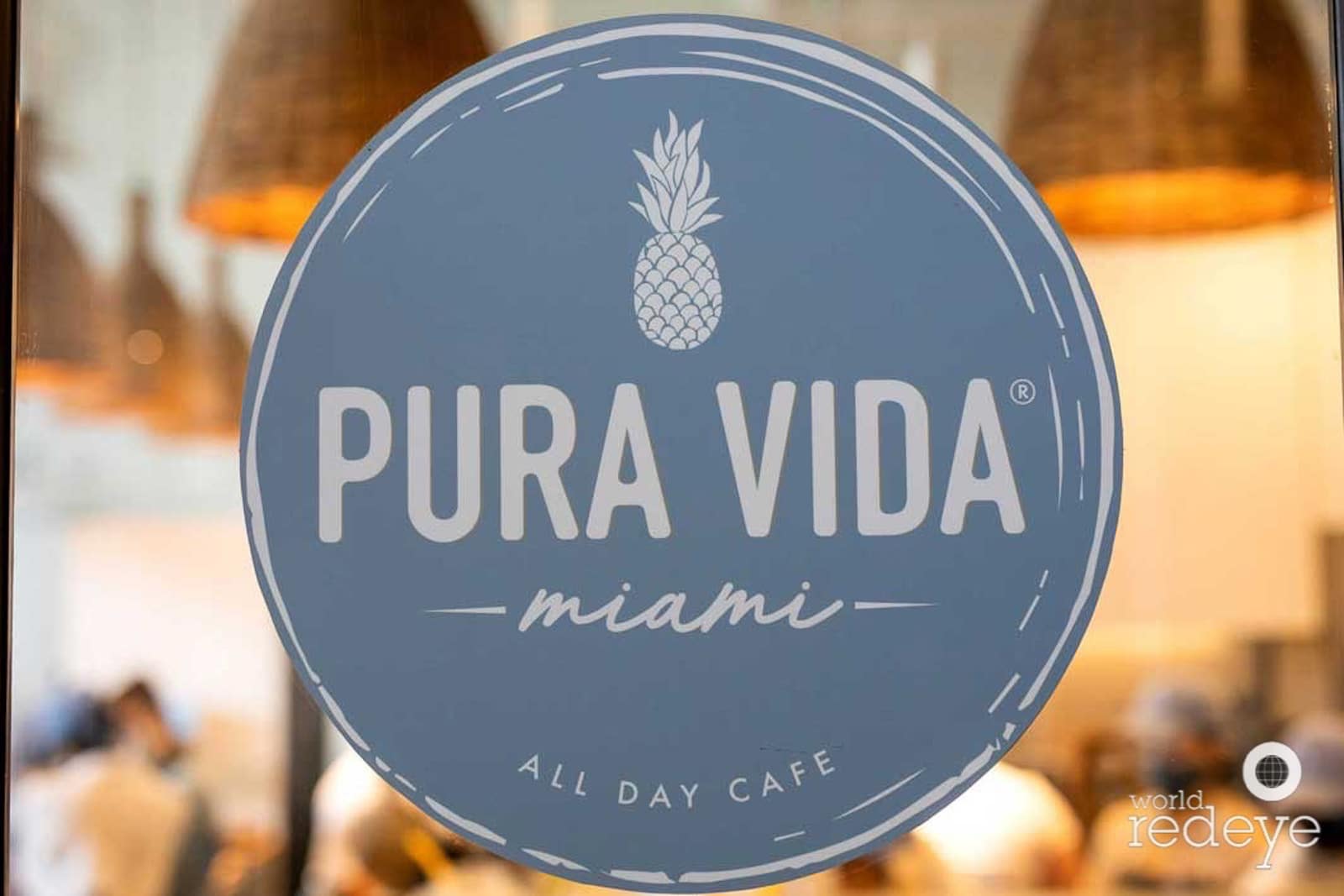
Pura Vida Las Olas, Miami
Creating a commercial space like this is challenging for clients as their customers often want privacy from the street while also having both an open and refreshing experience once inside. Our planters were the perfect solution!
View ProjectOur Favorite – Fiberglass Planters
Fiberglass is our favorite material, not only because the environmental impact of fiberglass is low, but also because our gardens and homes look great with it. On the downside, fiberglass pots are pricier than throwaway plastic ones, but consider the initial cost as an investment in a pot that will have years of use.
In addition, fiberglass is the easiest pot to arrange because it is lightweight and it won’t break. This makes fiberglass the best choice when you are container gardening and you want to clean, move, and tend to your pots often.
Material is just one advantage that makes fiberglass pots perfect for your next planter – there are many more.
To find out more trade secrets behind why fiberglass planters are so special, see our buyer’s guide to fiberglass plant pots.
